Message 769:
> Does anyone have the tech specs for the backpack parachutes for the 60's,
> 70's and 80's ejection seats? Especially the WAC/ Stanley seats of the B-52
> D and H models.
My 64-4 shows what appears to be a BA-18 with "T" ripcord handle. The descripton
metions that "one version of the back style automatic parachute is designed
specifically for some models of the B-52 aircraft." I think this is referring to some
crew positions that utilize the parachute harness rather than a seat harness- there are
lanyards that attach to the harness. It further says "Early design of harness for
back style automatic parachutes includes only one detachable riser..... the early design
also includes clover leaf ripcord in lieu of T-handle ripcord." That early mpde; used
the T-cover for the Capewell riser release. They reference stock numbers 1670-801-1670-
P/N 5007024-18 and 1670-802-8800 P/N 5007024-21 (I think this is the one for the B-52) It
is hard to believe that the basic design of the "BA" series of the late 50s is
still in use after 40+ years, and that today it is the only backpack-style parachute the
USAF uses. Rich
Message 770:
Hi folks, A rejoinder on the BUFF seat biz: When I was out at Tucson, a few years ago,
they were just finishing up the Salt II chop-job on the BUFFs. My bud, Jerry Fugere
(formerly of AMARC) and I toured the lots where the BUFF "chop-up" was going on.
We passed piles of all sorts of retrievable and resalable parts, including wheels, landing
gears, everything you could imagine. Among the piles of debris were a couple hundred BUFF
seats, including the Weber upward firing seats (Pilots and EWO), the Stanley downward
firing seats (Nav & Radar/Nav), and even the strange little Weber-built rear
tailgunner seats that were not ejectable (since the whole tail dropped off, via explosive
charge). I spent quite some time examining these seats specifically for evidence of TO
upgrades and mods & found that all of the seats there were from D, E, F, and a few G
models (H model still in service, of course). Most of the seats of both types (up and
down) were from the Ds, but were clearly the second generation Weber seat (not the first
one, which the BUFFs were initially equipped with. The earliest BUFFs used the same
standard early Weber seat that was fitted to many of the early 50s jets (even the first
YF-102 prototype). This seat used a standard MD-1 survival kit (as did all the early D
models). Initially, both upward Weber and downward Stanley models were used with BA type
back packs that had standard chute harness configurations; they used conventional auto lap
belts and shoulder restraints. There were still a few of these in those rows of BUFF seats
we surveyed, but most had been TO upgraded to use the inertia reel lock to clip onto the
chute harness (thereby allowing the chute harness to be used as a seat restraint. These
seats still used the latest updated auto-release seat belts, however. Initially, as Rich
said, only one riser was releasable (in the 50s); these one-side riser sets used a
"T" Capewell on the left side only. This was standard on all USAF back style and
seat chutes, including both fighter and bomber rigs. The "T" Capewells next were
standardised for use on both left and right risers, when it was found that safety
requirements necessitated complete release of the canopy under certain circumstances (such
as ditching at sea). This two-release riser set was and is in standard use on all USAF
personal parachutes, but in the very early 60s the more recent model "flat/rounded
triangle" Capewells replaced the early bilateral "T" model Capewells,
uniformly. The familiar D-ring ripcord release handle was also standard until requirements
of fast actuating auto-release systems in the newer ejection seats required a modification
that resulted in the newer "blast handle" design. The blast handle is that
"T" shaped aluminum ripcord handle that you find on chutes of the 60s vintage.
BUFFS (and most fighter jets) were TO updated in the 60s to use both the twin Capewell
riser release sets and the new 'blast handle'. The 'blast handle' stayed in use when the
BUFF seats were TO updated for the newer inertia reel to chute harness modification (that
allowed used of the chute harness as shoulder restraints). However, in the 70s, the 'blast
handle' ripcord release was found to have some unforeseen complications that became
apparent after a number of fatalities occurred in manual release mode. They were found to
be hard to manually grasp and pull cleanly in high G situations, if manual release mode
was needed, or when the pilot was disoriented or injured after ejection, and when fouling
of the auto systems required manual release. Hence the 'blast handle' was replaced by a
conventional D-ring ripcord handle, similar to the original type long in use in previous
decades and far easier to use in all circumstances. The latest BUFF seat configs (H
model), to the best of my knowledge, use the inertia reel to chute harness system, a
special fast acting lap belt release (releases from both sides, like F-4 type Martin-Baker
H7AF system), and a conventional D-ring ripcord handle. I have attached a few images that
show some of the Salt II removed seats, and a few others, with the hope that they may be
helpful. I have here at my place two BUFF seats that have been restored. The first is an
earlier D model Stanley downward firing seat (it used conventional BA-type chute with
standard harness, twin "T" Capewells, twin shoulder restraints, auto-release
lapbelt, and a D-ring ripcord handle). My BUFF EWO seat (same as the pilot seat,
basically, except it faced aft on the main flight deck) is a G model seat that features
the inertia reel to harness attachment, a fast-acting (smaller) auto-release seat belt
(belt releases on each side, not in the middle as the older systems did), twin bilateral
flat/round triangular Capewell releases, and a blast handle ripcord release (it was later
replaced by a conventional D-ring, as is the case on the current H models). Both of my
seats are equipped with rigid fiberglass seat survival kits (the upward seat with a
CNU-68/P kit and the downward seat with a CNU-155 kit). USAF TO 14S3-1-3, dated 15 Apr 85
shows B-52 aircraft seat survival kits as follows: B-52B, C , D models could use MD-1,
ML-4, or CNU-68/P, CNU-155/P, CNU-129/P kits ; F, G, and H models BUFFs can use all of the
above, except the MD-1 (which is/was obsolescent). The attached photos show several BUFF
seats, including my early Stanley downward firing model (without the chute and survival
kit); other photos shows the CNU-68/P seat survival kit from several angles (the pad
varies, as several were used). Be patient, as the photos may be informative and helpful.
Unfortunately, I have no immediately 'at hand' shots of my Weber G model upward firing
seat. Cheers, Chris

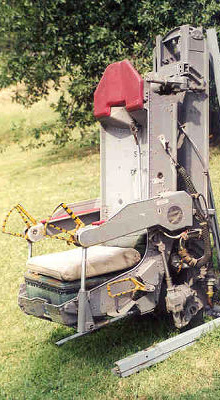
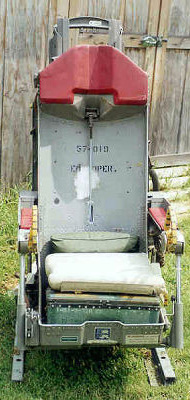
Three views of upwards ejecting seat from
B-52
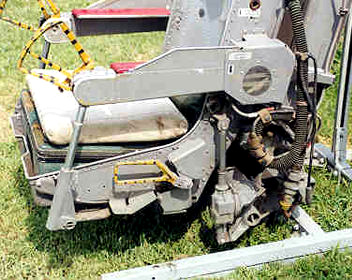
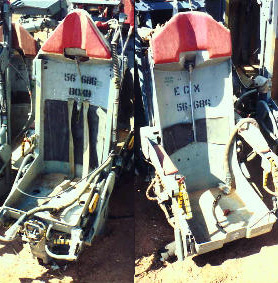
Left: Detail of upward ejecting seat from B-52G. Right: Seats from SALT II dismantled
B-52s
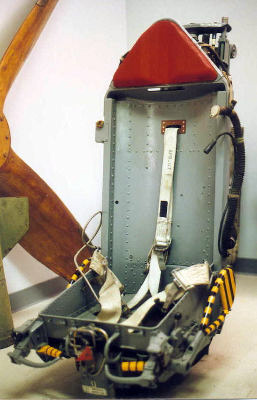
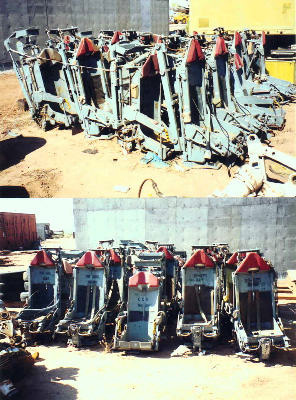
Left: B-52 Stanley downward ejecting seat. Right: Seats from SALT II dismantled B-52s
Message 771:
About the Salt II B-52 smasher at DMAFB: Would I be corrent in presuming that the ejection
seats met the same fate as the aircraft? Seems that I read somewhere recently that ALL
parts had to be destroyed. If so, what a waste. Wizzo
Message 775:
Thanks Rich, This helps out. The last time I flew in the B-52, 1984, we were using a BA-xx
derivative. I think it was a BA-21. I am trying to find out, for sure, to restore my H
model upward DECM seat, to that era. I have a D model seat that could have used a number
of different versions of BA chutes, since that model was around for a while, too. Steve F.